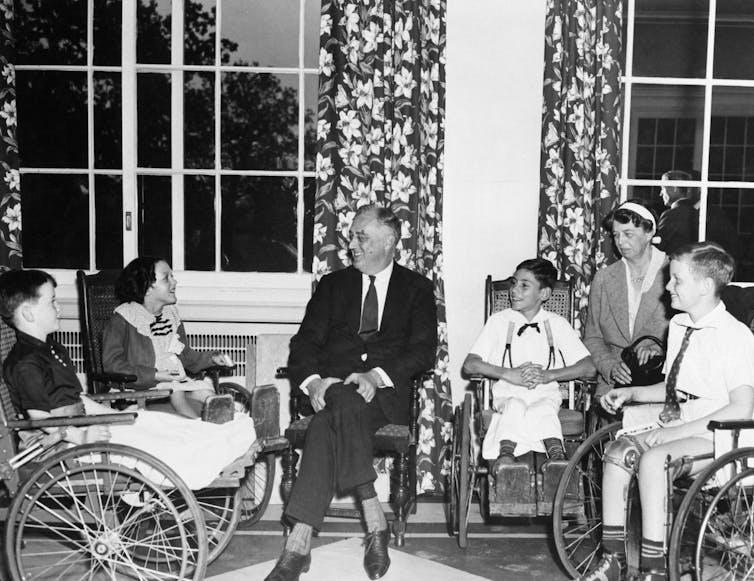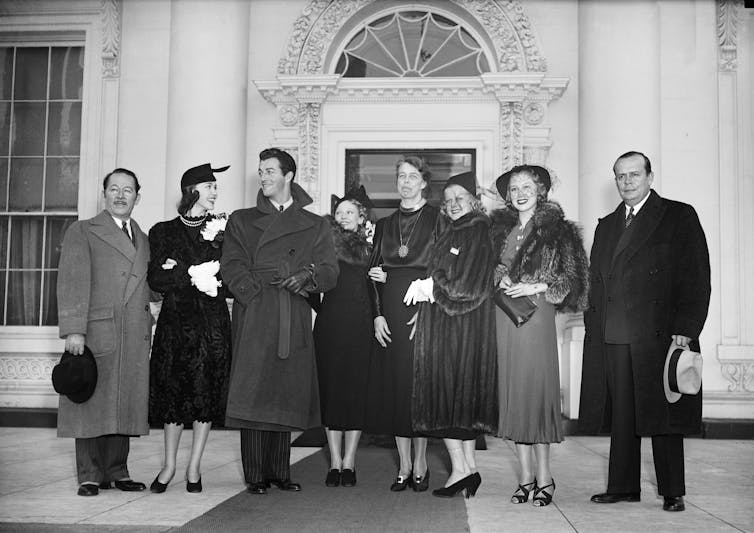Thomas Doherty offers a reminder of the lesser-known battle that FDR waged, in public and in private.

By Thomas Doherty
Brandeis University
 Throughout much of the last century, a lethal and terrifying virus besieged America. Then, as now, the fear of contagion gripped ordinary Americans. And then — unlike now — a president displayed decisive leadership in fighting the virus, maintaining an unfailingly good humor and leaving the immunology to the experts.
Throughout much of the last century, a lethal and terrifying virus besieged America. Then, as now, the fear of contagion gripped ordinary Americans. And then — unlike now — a president displayed decisive leadership in fighting the virus, maintaining an unfailingly good humor and leaving the immunology to the experts.
The scourge was infantile paralysis, or polio, and the president, Franklin Delano Roosevelt, was its most famous victim. First clinically described in the late 19th century and persisting deep into the 20th century, the virus invaded the nervous system and destroyed the nerve cells that stimulate muscle fibers, resulting in irreversible paralysis and sometimes death.
The tally in heartbreak and death was staggering. In “Polio: An American Story,” the historian David M. Oshinsky chronicles the loss. In 1949, of the 428 cases recorded during an outbreak in San Angela, Texas, 84 victims — most of them children — were left paralyzed and 28 died.
In 1946, there were 25,000 reported cases across the country. By 1952, the figure had jumped to 58,000. Unlike the Spanish flu, whose special horror was to strike down the healthy in the prime of life, and COVID-19, which places the elderly at greatest risk, polio targeted children mainly, crippling and killing with what seemed an almost premeditated malice. Always on the alert for symptoms, generations of parents felt a chill of their own when a child contracted a cold, complained of a headache or had a stiff neck.
>Please Donate to CNs’ 25th
Anniversary Spring Fund Drive<<
In this sense, FDR was both a statistical anomaly and cautionary lesson. He was stricken with the disease in 1921, at the age of 39, grim proof that wealth and privilege granted no immunity. Against long odds, he was elected governor of New York in 1928 and, in 1932, to the first of four terms as president. During his first presidential campaign, Republicans whispered that a wheelchair-bound “cripple” was unfit for the duties of the presidency.
“It is perfectly evident that you don’t have to be an acrobat to be president,” snarled Al Smith, the former New York governor.
FDR’s Personal Crusade
As president, FDR made the eradication of polio his personal business. For media historians like myself, FDR has always been a towering figure for his prescient orchestration of electronic media — in this case, the radio — to forge his persona and further his policies. “My friends,” he would begin intimately, in his calming, conversational “fireside chats.” Less well known perhaps is his pioneering role as executive producer of a programming evergreen: the celebrity-driven fundraiser.
Beginning in 1934, he dedicated his birthday, Jan. 30, to a nationwide series of charity galas and “birthday balls” held to benefit the Warm Springs Foundation for Infantile Paralysis, named for the polio treatment site in Georgia he had been visiting since 1924. First Lady Eleanor Roosevelt — not just FDR’s strong right arm but his legs as well — typically took on hostess duties, circulating among the guests and hustling back and forth among ballrooms around the capital.
And what swell parties they were. The 1937 bash attracted 15,000 donors and lookie-loos angling to get a glimpse of the main attractions, Metro-Goldwyn-Mayer stars Jean Harlow and Robert Taylor. FDR called the money raised from the annual events his “finest birthday presents,” but he was not loath to accept other party favors. “Surround me with pretty girls at the luncheon,” he instructed the organizers of the 1941 celebration — and he was seated between Lana Turner and Maureen O’Hara, as a bemused article in Variety magazine recalled in 1945.
In 1937, FDR announced the establishment of a new charity created expressly “to lead, direct and unify the fight on every phase of this sickness.” It was called the National Foundation for Infantile Paralysis, but everyone knew it as the March of Dimes.

Radio and motion picture superstar Eddie Cantor coined the phrase in 1938. He reasoned that even Depression-battered Americans wouldn’t begrudge a dime to a good cause. Cantor’s annual March of Dimes variety shows were simulcast by all the major radio networks, featured the biggest entertainers of the day and set a template for every all-star telethon broadcast by radio’s successor.
“A little change from big people will mean a big change in little people!” chirped Molly of the radio duo Fibber McGee and Molly, the Hollywood Reporter reported in January 1942. Dime by dime, the campaigns raked in millions.
However, as with the victory over Japan and Germany in World War II, the conquest of polio was a surrender ceremony FDR did not live to witness. On April 12, 1945, he died of a stroke while visiting the Warm Springs spa.
Repurposed now as a fitting memorial to the late president, the March of Dimes campaign soldiered on. And, eventually, the medical research it supported paid off. On April 12, 1955, on the 10th anniversary of FDR’s death, the field trials for the oral vaccine developed by Dr. Jonas Salk were declared a success. A wave of nationwide jubilation ensued.
In those days, there was no such thing as an anti-vaxxer: Almost every American knew someone who had been stricken. By the mid-1960s, together with a more easily administered oral vaccine introduced by Dr. Albert Sabin in 1961, polio had been effectively eliminated as a public health menace in the U.S. It exists now only in isolated pockets in the poorest regions of developing nations.
Sorrowful Salute
Shortly after the success of the Salk vaccine, FDR’s fight against polio was given an elegiac salute in Dore Schary’s play “Sunrise at Campobello,” named after the island off the coast of New Brunswick where FDR was first stricken. It showed the late president as Americans never saw him — flat on his back, carried on a stretcher, falling on his face and crawling backwards up the stairs — before he reemerges to public life, in braces and crutches, at the 1924 Democratic Convention.
A generation of hard-boiled theater critics waxed sentimental at the portrait of a president many had voted for four times. A “deeply moving chronicle … of a vigorous man struck down by a terrible illness,” wrote Brooks Atkinson in The New York Times. “What rose from the invalid’s chair was greater than what had climbed into it.”
“Sunrise at Campobello” opened on Broadway on Jan. 30, 1958 — the president’s birthday — and the film version premiered in New York on Sept. 23, 1960, in time to give another patrician Democrat with liberal credentials then running for president a vicarious boost. The opening night’s proceeds from both the stage and screen versions were donated, of course, to the March of Dimes. It was a reminder of the other great battle that FDR waged, in public and in private.
Thomas Doherty is professor of American Studies at Brandeis University.
This article is republished from The Conversation under a Creative Commons license. Read the original article.
Please Contribute to Consortium News’ 25th Anniversary Spring Fund Drive
Donate securely with  PayPal here.
PayPal here.
Or securely by credit card or check by clicking the red button:

Indeed, Mr. Chuckman. The United States post WWII is a case study in power corrupts and absolute power corrupts absolutely.
The first polio vaccine, the Salk vaccine, was not an oral vaccine, but was injected. I remember it well.
FDR was a great president, America’s greatest, likely, only Lincoln offering serious competition.
His inspiring voice, his attention to many details not concerning great affairs of state, his often brilliant appointments, plus our awareness that all of his efforts were those of a severely disabled man, something not known to his contemporaries – all argue for him to be considered as the country’s greatest leader in a crisis.
Two crises, actually – a great economic depression, with America’s agricultural Dustbowl thrown in, and a vast world war.
And that war wasn’t against enemies generated by fevered ideology and resentment, it was against some of the most frightful monsters in history.
What a contrast to Trump, a man literally obsessed with himself, a man incapable of an inspiring thought or act, a man of no generosity of spirit, a man whose workaday language is from the gutter, and a man many of whose appointments are among the nastiest and most contemptable in memory.
The two, side by side, almost perfectly summarize what has happened to the heart and soul of the country over the era of the American empire, from the end of WWII, when it arose from the ashes of war, generating myths about its remarkable efforts, until now, a time when many astute observers see it as corrupt and arrogant and in unavoidable relative decline with its leaders desperately flailing in all directions.
From a time when much of the world actually welcomed America’s leadership with smiles until now when much of the world’s people would like America to go home, stop terrorizing people, and mind its own business – those kinds of things being said by both competitors and allies.
The view of FDR as a great figure over the years since his death has only grown with even many Republicans – who, at the time, despised him – embracing it. Otherwise, there would be no Roosevelt Memorial in Washington. The view of Donald Trump has gone in just a couple of years from a few modest hopes for change from a man never regarded as admirable to widespread acceptance of his incompetence and corruption.
In that period, we’ve gone from a genuine sense of a moral and ethical purpose about America to an overwhelming sense of its selfishness and arrogance and corruption. It is a very long journey completed in only about eighty years.
From the “Four Freedoms” and inspiring “Fireside Chats,” to “America First” and “full spectrum dominance” with television performances worthy of some boisterous crowd waiting in a car at a McDonald’s Drive-through. From “The only thing we have to fear is fear itself” to not a word of empathy, stealing other people’s medical supplies, and an unprecedented campaign of hate-speech against another great country and its people.
FDR literally embodied hopes and dreams for a great many people in the world. The dreams represented by Trump are the ugly ones, anxiety dreams and nightmares. He represents hate and envy and suspicion, not hopes or principles, and he has worked tirelessly to increase the world’s stock of human misery and oppression.
Jonas Salk unlike the present rapacious Big Pharma vaccine-producers, gave his invention to the world, not making a big profit for himself.